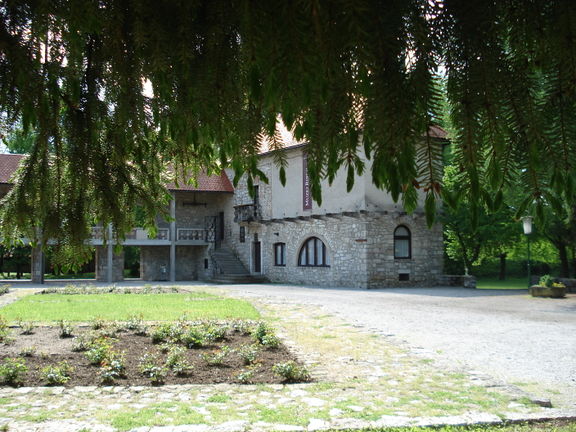Difference between revisions of "Ribnica Castle"
Ivan Pirnat (talk | contribs) m |
(English proofreading & corrections 1 / changed status to PROOFREAD DONE) |
||
| Line 1: | Line 1: | ||
{{Article | {{Article | ||
| − | | status = INFOBOX | + | | status = INFOBOX NIFERTIK! |
| maintainer = Ivan Pirnat | | maintainer = Ivan Pirnat | ||
}} | }} | ||
| Line 20: | Line 20: | ||
{{Teaser| | {{Teaser| | ||
| − | [Ribnica Castle] in centre of town Ribnica some | + | [[Ribnica Castle]] in the centre of the town of Ribnica some 50km to the south of Ljubljana had a strategic position on the market trail towards the town of Kočevje and port of Rijeka (formerly Fiume) on the Adriatic sea. The castle was first mentioned in 1264 as Reuienz and in its nearly 8 century history it has housed many eminent Slovenes. The famous Renaissance composer [[Jacobus Gallus Carniolus]] was born there in 1550. From the neighbouring villages of Ribnica come the linguist [[Stanislav Škrabec]], the cartographer [[Peter Kozler]] and the politician [[Janez Evangelist Krek]] in their honour a park was opened on the castle grounds in 1982. [[Mikl House Museum]] was established in the [[established :: 1958]]. It focuses on an ethnographic collection presenting the people of Ribnica and their famous wooden arts and crafts called ''Suha roba'' ("dry goods"). In the 1980s artist colonies began to be organised and artists participated in forming Forma Viva in the castle's park. |
==History of the Castle== | ==History of the Castle== | ||
| − | Ribnica as feudal land of the Aquileian Patriarchate was first mentioned in 11th century. | + | |
| − | Eventually in the early 19th century the property passed to the Rudež family, its last-known owners. It was sold to the Yugoslav Government in 1937 | + | Ribnica as a feudal land of the Aquileian Patriarchate was first mentioned in the 11th century. Two centuries later written sources testify of [[Ribnica Castle]] as Reuienz. Around 1220 the castle was owned by the Auerspergs, who had got the castle from the Žovnek family as dowry. In the middle of the 13th century the Ortenburg family divided the land among themselves. In the 15th century the Counts of Celje had got the castle back since they derive from the Žovnek family. In later dynastic struggles with the Habsburgs they lost and upon the murder of the last Count of Celje, Ulrik II, in 1456, the Habsburg family acquired all of their possessions. Many owners changed hands from the 16th to 19th century: Lamberger, Moscon, Gall, Khisel families and the Counts of Kobenzl. |
| + | |||
| + | Eventually in the early 19th century the property passed to the Rudež family, its last-known owners. It was sold to the Yugoslav Government in 1937 as a military base. During the Second World War the castle saw the same sad fate as many other castles in this region; it was burned down and afterwards was used as hospital for Partisans in 1944 who had to flee the Germans. The castle had an inner courtyard and two residences before that, after burning only the two defence towers and the passage which link them as well as the foundations of the old castle remained. The renovation of what was left started after the WWII, but a lack of funds brought the castle to ruin again. The [[Mikl House Museum]] was crucial for its renovation and today maintains the castle in its current state. | ||
}} | }} | ||
| Line 36: | Line 38: | ||
* [http://www.ribnica.si/?lng=eng&vie=cnt&gr1=his&gr2=&gr3=&id=2005070115223338 Ribnica Castle on Ribnica Municipiality website] | * [http://www.ribnica.si/?lng=eng&vie=cnt&gr1=his&gr2=&gr3=&id=2005070115223338 Ribnica Castle on Ribnica Municipiality website] | ||
* [http://www.miklovahisa.si/galerija/muzej_3d/ Virtual Museum on Mikl House Museum website] | * [http://www.miklovahisa.si/galerija/muzej_3d/ Virtual Museum on Mikl House Museum website] | ||
| − | * [http://www.gradovi.jesenice.net/ribnica.html Ribnica Castle on Milan's | + | * [http://www.gradovi.jesenice.net/ribnica.html Ribnica Castle on Milan's web page] |
* [http://www.burger.si/Ribnica/seznam.html VR panorama of Ribnica Castle on Burger.si website] | * [http://www.burger.si/Ribnica/seznam.html VR panorama of Ribnica Castle on Burger.si website] | ||
| − | * [http://sl.wikipedia.org/wiki/Grad_Ribnica Castle Ribnica on Slovene Wikipedia] | + | * [http://sl.wikipedia.org/wiki/Grad_Ribnica Castle Ribnica on Slovene Wikipedia] (in Slovenian) |
* [http://en.wikipedia.org/wiki/Jacobus_Gallus Jacobus Gallus Carniolus on Wikipedia] | * [http://en.wikipedia.org/wiki/Jacobus_Gallus Jacobus Gallus Carniolus on Wikipedia] | ||
* [http://en.wikipedia.org/wiki/Peter_Kozler Peter Kozler on Wikipedia] | * [http://en.wikipedia.org/wiki/Peter_Kozler Peter Kozler on Wikipedia] | ||
[[Category:Monuments and sites]] | [[Category:Monuments and sites]] | ||
Revision as of 23:24, 3 March 2010



